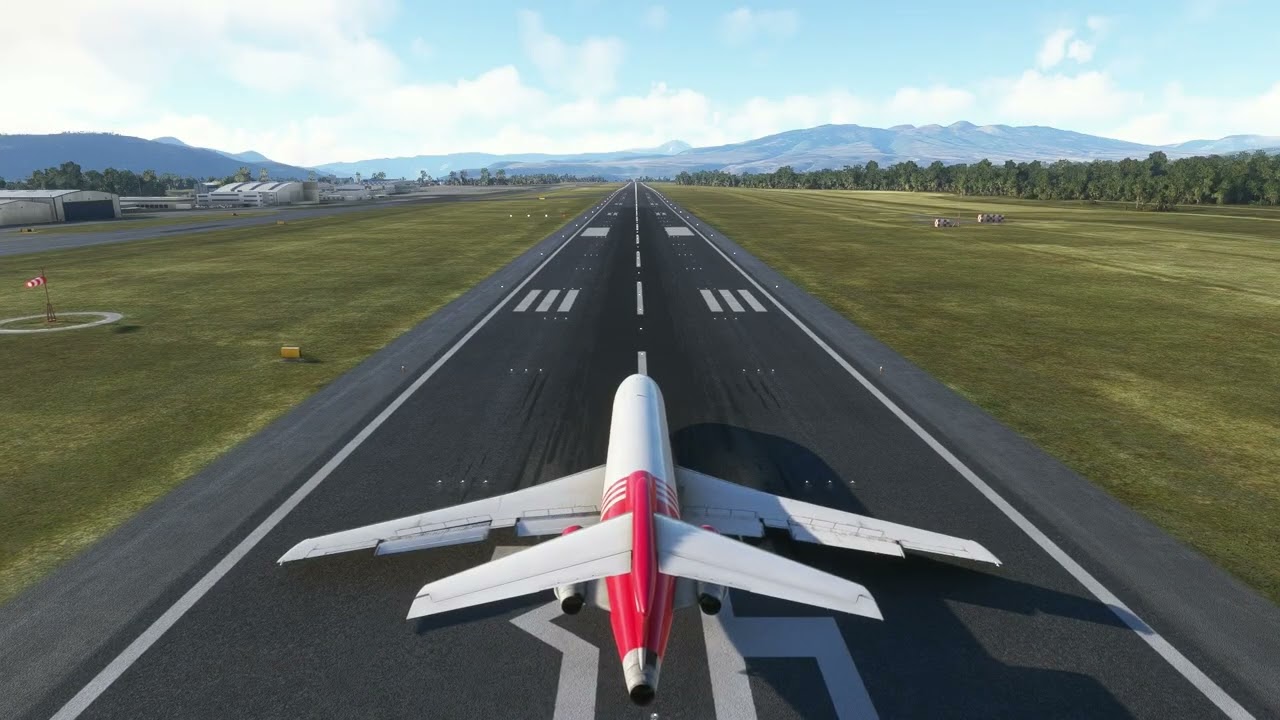FlightSim Studio has entered the vintage jet market with the release of its Boeing 727-200 Freighter on August 6, 2024. This represents a stark departure from the developer’s previous offerings of the highly automated and modern Embraer E-Jets and Tecnam GA aircraft. Instead, we get an old, loud, and fully analog jet that’s barely even in use anymore, just how I like it. In this review, I’ll take a look at how well FlightSim Studio (FSS) has adapted to this change by seeing what the FSS Boeing 727-200F for Microsoft Flight Simulator has to offer.
FlightSim Studio 727-200F Review Setup
This aircraft is exclusively for Microsoft Flight Simulator and is only available on PC at the moment, so that is where the review was done. For my PC setup, I have a Ryzen 5 5600X CPU, an AMD RX6700XT graphics card, 32 GB of RAM, and an NVMe SSD. For peripherals, I have the Honeycomb Alpha yoke, Honeycomb Bravo throttle quadrant, and MFG Crosswind V3 rudder pedals.
For some info on my simming style, I’ve been in the hobby since around 2014. As my profile description suggests, I fly all sorts of aircraft, from A320s to DC-6s, though my main interest lies in general aviation and retro/vintage aircraft, so I was quite looking forward to the release of this 727. The aircraft was bought by myself with my own money, so my opinions in this review are as honest as can be.
I am not a pilot, much less a 727 pilot, so all my knowledge of the real plane is based on research I performed, mostly from Benson’s boeing-727.com, Andras Sobester’s awesome Design Deep Dive series, and the developer’s own documentation.
A Small History Lesson
Although it may not seem like it today, the Boeing 727 was quite the pioneer of aviation technology back in its time. Introduced in 1964, the objective of the 727 was to make an aircraft that was suited to both small runways and short to medium-haul routes. This meant falling somewhere in between the short-range feasibility of the twin jets of the time, such as the DC-9 and Caravelle, and the long-range versatility of Boeing’s other jet, the 707. It also meant takeoff distances would have to be short, ideally less than five thousand feet.
Achieving these requirements was no easy task in the late 50s/early 60s. Jet engines were still in their relative infancy, and as a result, demanded tons of fuel to produce a lot of noise and smoke for not that much thrust. Taking off and landing on such short runways while also being able to fly far and fast also forced the engineers at Boeing to carefully consider the aerodynamic design of this new jet.


AA image licensed under CC BY-SA 2.0. DHL image licensed under GNU FDL. No changes were made to either.
The result was a quirky, but revolutionary design. According to Andras Sobester, the 727 was “the first trijet airliner in service, the first aircraft with triple-slotted flaps, the first transport with an APU, the first and only airliner with a nose gear brake, the first aircraft with perforated inlet liners for fan noise reduction, [and] the first big jet designed for sub-five thousand-foot runways.” This exceptional design paid off for Boeing, with the company producing over 1800 727s throughout its production run from 1962 to 1984. Some 727s are even still flying to this day as freighters, mostly in South America and parts of Africa.
The previous quote comes from Andras Sobester’s Design Deep Dive series videos on the 727, which I highly recommend you watch if you are interested in finding out more about the 727’s very interesting history and design considerations. Now that you have an idea of what a truly legendary aircraft the 727 is, let’s move on to FSS’ rendition.
Installation and User Experience
The FSS 727-200F costs €33,57 EUR and is available on the Aerosoft store and on Contrail. Only the freighter variant is included, though FSS does plan on releasing a passenger version either as an update or as a standalone product. It comes with 16 different liveries, including a blank livery, FedEx, Amerijet, DHL, and everyone’s favorite overweight operator, Aerosucre. I think the liveries included look quite good and accurate to their real counterparts, even including some of the dirt and grime you might expect from such an old bird.
The “EFB” included is actually a paper clipboard, which is a great way to provide the functionality of an EFB while keeping things period-correct. It has most of the functionality you would expect from an EFB, including door opening, settings, weights management, takeoff and landing performance calculations, a TOD calculator, and Navigraph charts. The EFB has SimBrief integration, which makes setting the payload as easy as clicking one button.


As was typical of large aircraft in the 1960s, the 727 requires a crew of three to fly. Since we are mostly relegated to single pilot ops in MSFS, this means you’ll have to take on the role of the captain, first officer, and flight engineer all at the same time. Thankfully, FSS includes a small phone that serves as a crew manager. It includes various assists, such as automatic fuel balancing, pack temperature monitoring, and more. This crew manager also includes automated checklists, so you can actually ignore the engineer’s panel entirely if you want and just use the crew manager to handle those tasks.

Documentation is not included in a PDF like with most other developers. Instead, it’s all available through the FSS website. I quite like this documentation hub, as the way it’s laid out with the different categories makes it easy to find exactly what I’m looking for quickly. For those who just want to get into the air, the quick start guide tells you how with the use of the crew manager. For those who want to go in-depth and learn about the flight engineer’s job, the rest of the checklists do a good job of explaining what needs to be done.
Exterior and Interior Modeling
To start, the exterior model looks quite accurate. The front gear is nicely modeled, with the tires including the characteristic chines, which are used to improve wet weather performance. As mentioned before, the 727 was the first and only airliner with nose gear brakes, however, this model must represent one of the later 727s that had these brakes removed, as they have not been included.
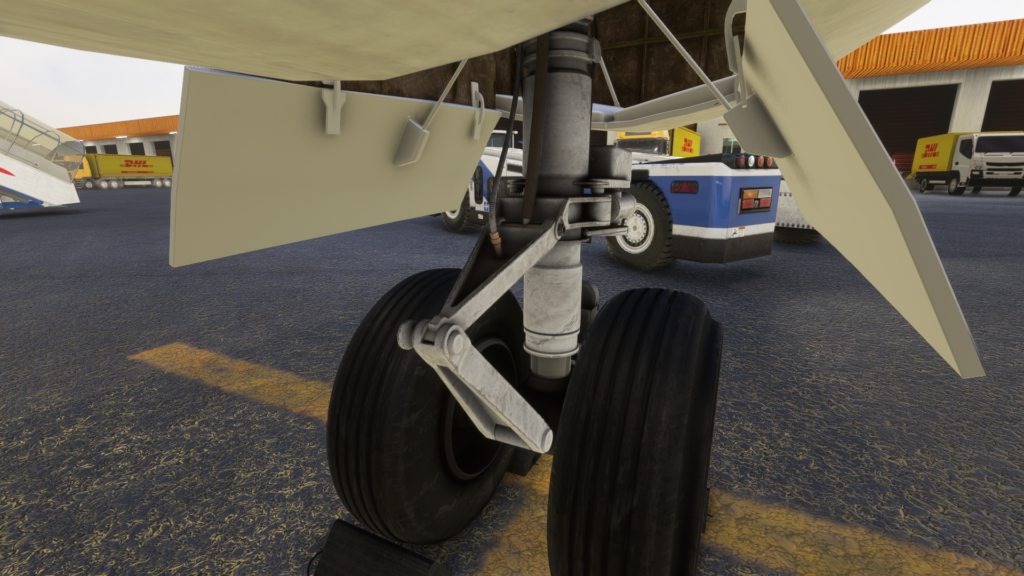
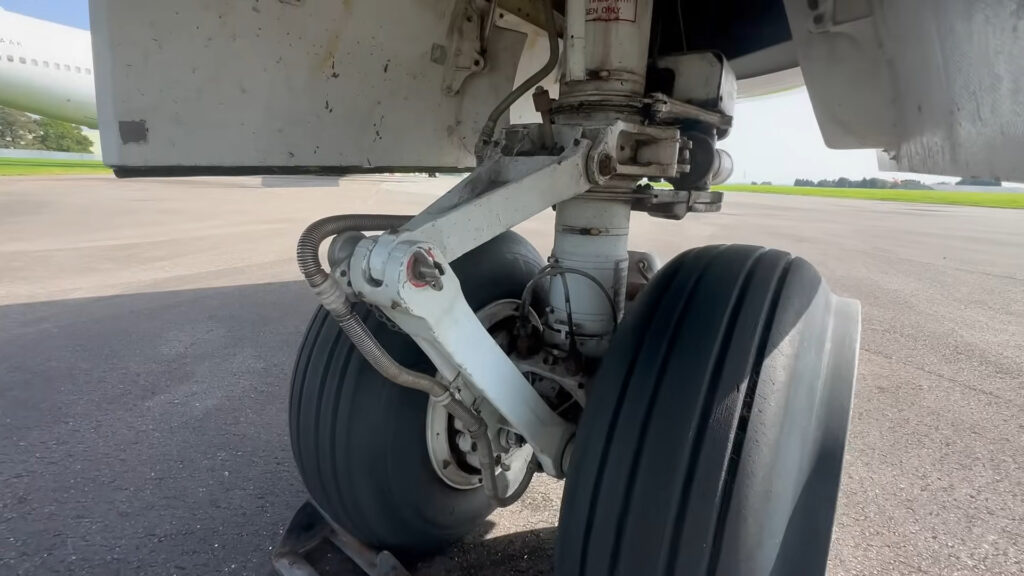


Moving on to the main gears, these also look good, featuring all the hydraulic lines we expect to see from the real aircraft. It also features a characteristic piece of the 727’s gear, the curved I-beam, which is responsible for closing the gear door. The main gear well is textured and nicely detailed. The only things that stand out to me here are how flat the gear door is compared to the real one and the fact that the curved I-beam isn’t quite attached to the gear door.

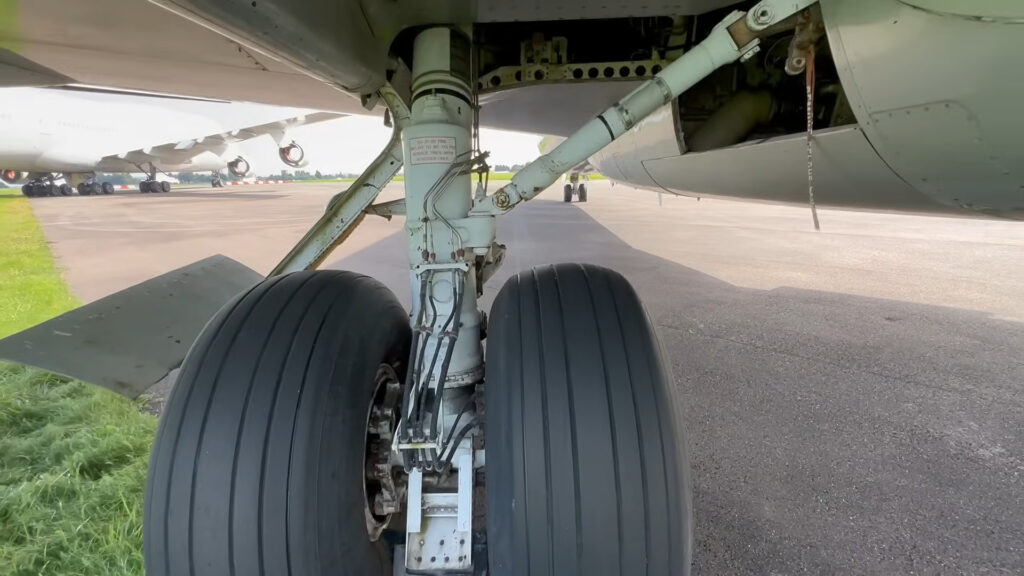


Another important design characteristic of the 727 is its triple-slotted flaps, which have been modeled excellently here.


The tail features yet another design quirk of the 727, its split rudders. Upstream of the rudders is a row of vortex generators, which are used to give the rudder more authority at lower speeds.


And here are some views of the whole aircraft, which looks gorgeous.




Interior
Now onto the interior modeling. The cockpit and its textures look fantastic. There’s a tasteful amount of wear to the surfaces, about what would be expected of such an old aircraft. The glass on the instruments has some slight scratching and dust. The nighttime lighting also looks great.


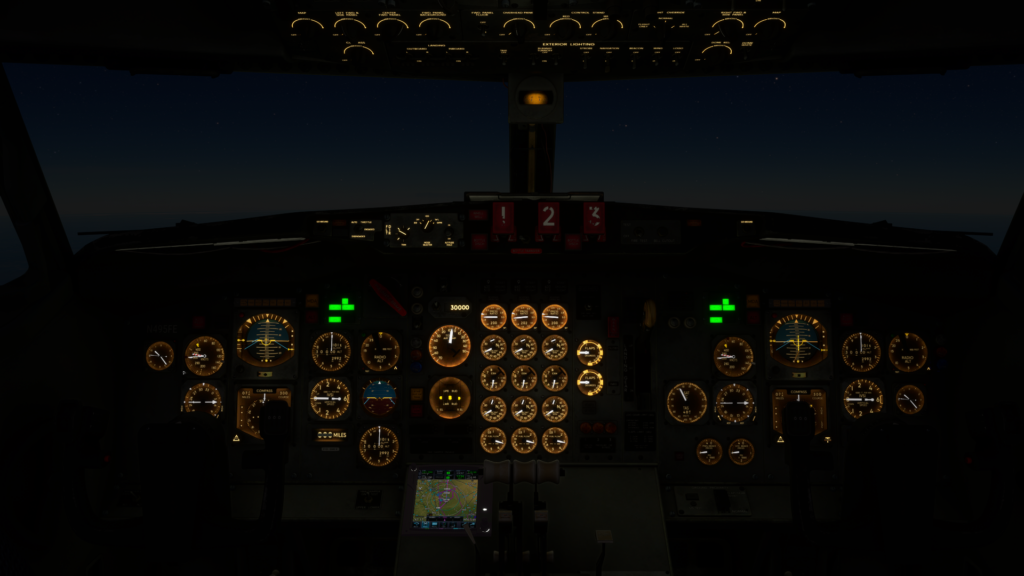

The small galley section features some functioning controls for the cargo bay. With these, you can open the main cargo door and control the lights for both the cargo bay and the galley. Unfortunately, the lights that indicate the status of the door do not work. This section also has a click spot to manually open the passenger door and a click spot on the side of the wall removes a section of the panel and allows us to venture into the cargo bay.


The cargo bay features custom models for the cargo. The cargo on board includes some small and large boxes, a couple of yellow fuel tanks, and some horses. The rear of the cargo bay gives us access to the airstair, which features no side panels and allows us to see all the fuel and hydraulic lines and also engine 2’s s-duct.


Systems
To prepare for this section, I researched some of the 727’s systems and their expected behaviors in different situations. I then wrote down a series of tests to perform in the sim to see if the behavior of the systems is accurate.
For those intimidated by the age of the aircraft and the presence of a flight engineer’s panel, just know that it’s actually not as hard to adapt to the systems as it might seem. If you’ve flown a 737 before, you’ll probably recognize many of the systems on the engineer’s panel, and will probably be able to get it up and running without too much reading/tutorialing. The crew manager’s automated monitoring settings also help with keeping things like the fuel in balance and the packs cool in case you’re too busy flying the plane. The largest difference will be in the navigation systems, which I’ll get into in their section.
Hydraulic
Unfortunately, the hydraulic system has a lot of issues and isn’t very accurate as a whole. The 727 has two hydraulic systems, A and B. System B is controlled by two electric pumps while system A is controlled by engine-driven pumps on engines one and two.
The first issue seems to be that engine two’s pump is bugged or doesn’t work, as turning on and off this pump had no effect on system A’s pressure. It seems that system A is entirely driven by engine one, and this pump, even when turned off, keeps supplying pressure to the system.


Each of these hydraulic systems controls a set of flight control surfaces and systems. System A controls the nose wheel steering, landing gear, tail skid, trailing edge flaps, ground spoilers, leading edge flaps, the lower rudder, the ailerons, the elevators, and the outboard spoilers. System B controls the brakes, inboard spoilers, upper rudder, aft airstairs, ailerons, and elevators.
All of these systems, except for the flaps, worked despite their corresponding hydraulic system being turned off. In case of a loss of hydraulic pressure, the yokes will move small control tabs that use air flow to move the bigger control surfaces, yet without hydraulic pressure, I was able to move the control surfaces in their entirety, while the control tabs didn’t move.
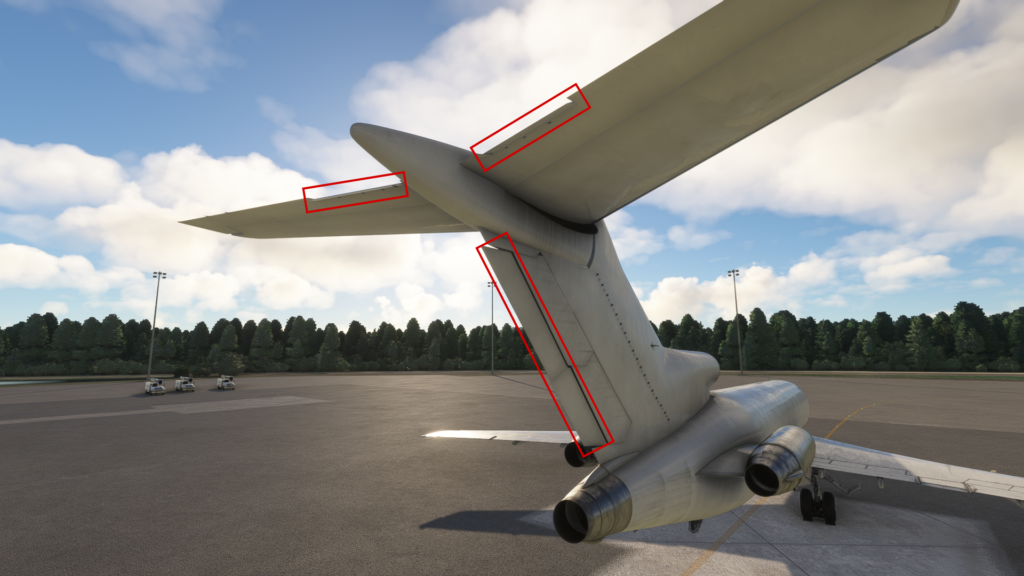

A good thing about the hydraulic system is that the backup system does appear to be simulated correctly. The backup system supplies a part of system B’s fluid to an electric pump that is turned on when the alternate flaps or standby rudder systems are activated. In both of those circumstances, the backup system turned on in the sim, allowing for the operation of the systems mentioned.

Note: Just before publication, FSS released update 1.0.3. This update addressed the issue of being able to move the control surfaces with no hydraulic pressure by making the control wheel return to the center whenever it’s moved. Some, but not all of the systems that use hydraulic power have also now been assigned to their correct systems.
Pneumatic
The pneumatic system is not much different, with many things incorrect or missing. The -200 variant of the 727 has an Auto Pack Trip system that automatically turns off both packs if it detects an engine failure on takeoff. The Auto Pack Trip light will turn on if the flaps are not set to zero, the pack trip switch is set to normal, and all engines are above 1.5 EPR. In the sim, this light does turn on under these conditions, except that it also turns on with only one engine above 1.5 EPR. Furthermore, despite the light turning on, the packs don’t actually trip off on engine failure during takeoff.

Crossbleed starts (starting an engine with the bleed air of another) should be possible, but they are not yet implemented. The engines only start using APU bleed air currently. The engines don’t start without pneumatic pressure, which is expected.
The pressurization system works fairly well. The AUTO mode will automatically pressurize and depressurize the cabin for the flight altitude and landing altitudes that are set. The standby mode will pressurize the cabin until the set cabin altitude; it also allows the manual selection of the cabin’s climb and descent rates. The manual modes are used to manually change the position of the outflow valve. These modes all work as expected except for the manual mode, which causes the cabin climb rate to shoot up as soon as the outflow valve is opened, which is incorrect.


One last thing I noticed is that the packs don’t seem to keep the cabin warm. Despite the temperature selector being set to the warmest setting and the cargo heat outflow being set to normal, the cabin remains at or below zero degrees in flight. It’s worth noting that the developer has said on its Discord server that the pneumatic system is receiving a rework, so these issues might be fixed once this rework is implemented.
Electrical
The electrical system doesn’t have as many flaws as the other two. One of the quirks I noticed is that the generator drives can be reconnected if they are moved out of the disconnect position. When the generator drives are disconnected, they are mechanically decoupled from the engines driving them, and they can only be reconnected on the ground by maintenance personnel.
Another thing I noticed is that the essential power source failure light does not turn off when a generator is selected and said generator is tripped off. In the real aircraft, the essential AC bus can be powered without the selected generator being on. On the other hand, if the field switch for that generator is not closed, it won’t generate electrical power and therefore will not be able to power the essential bus. In the sim, the essential bus worked despite the field switch for that engine being tripped off.


Engines
The 727 could be fitted with a few different variants of the same engine, the Pratt & Whitney JT8D. The JT8D is a low-bypass turbofan that was introduced in 1963 with the 727, though it was also used in the 737 Classic and the DC-9/MD-80. FSS’ version of the aircraft simulates the JT8D-9A variant of the engine.

The engines have been simulated pretty accurately for regular operations. I checked the temperatures on takeoff power settings and the EPR at altitude, and these seemed to match closely enough. Keep in mind that not every aircraft and engine is going to have the same temperatures and power output, especially when they get this old. The cruise EPR settings didn’t match the charts very closely, but the power required in cruise is also determined by aerodynamic drag, which might not be correct; more on that later.



A couple of other things that were correct about the engine behavior include the ignition not engaging if the thrust levers aren’t idle, and the oil temperature rising when power is reduced. On previous versions of the aircraft, there was a bug where the EGT and fuel flow would rise despite not introducing fuel, but this has been fixed in the latest version.
Some things that I noticed were incorrect include the inability to do in-flight restarts, the fuel temperature never going below 17° C (which means I couldn’t test the fuel heating system correctly), and the fuel heater not causing the oil temperature to rise and/or the EPR to change.
Navigation / Autoflight
And last for the systems checks is the navigation and autoflight. The FSS 727 has many navigation options, including the Garmin GNS530, the Garmin GTN750 (TDS & PMS), and the CIVA INS. The Garmin units worked fine for me and are common in GA aircraft, so I won’t talk about them; instead, I’ll focus on the INS. FSS is also working on yet another navigation option for a future update, the Honeywell GNS-XLS, which is an older style of FMC.

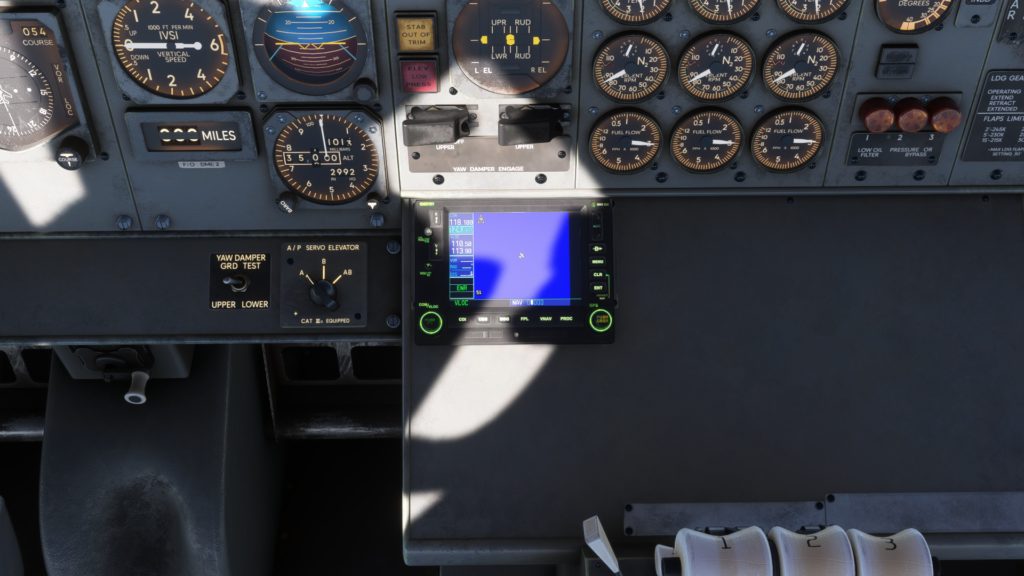


The real star of the show here is the CIVA INS. As far as I know, this is the first commercial aircraft in MSFS to have a functioning CIVA INS, and its implementation here is very good. For those who don’t know, the CIVA INS’s capabilities lie somewhere between VOR-to-VOR navigation and FMCs. It uses inertial sensors to essentially “dead reckon” the aircraft’s position based on its movement. Up to nine waypoints can be programmed into the CIVA INS in the form of coordinates.
The INS, like modern-day IRS systems, must be aligned before it can be used. This is done by setting the aircraft’s coordinates on the “POS” display while in standby mode, and then setting the INS to align. I recommend using the third-party Shift+Z stats tool to know your position in case you don’t have a chart handy. The alignment can take a long time, which is realistic; thankfully, FSS included the option to instantly align the INS by clicking on the “ready nav” button for those times when you need to get going right away.


Inputting the rest of the waypoints is rather straightforward. This is done by choosing waypoints one through nine on the waypoint selection wheel and setting their coordinates. If you have more than nine waypoints in your flight plan, you must wait until you’ve flown past some of your waypoints and then overwrite them with the rest of the waypoints in your flight plan. Inputting the waypoints can also take a while, though it can be done while the INS is aligning. If you’re too lazy to put them in yourself or you need to get going quickly, you can also import the coordinates from your SimBrief flight plan by hitting the “REMOTE” button.
INS systems, due to their reliance on the inertial sensors alone to determine location, accumulate errors over time. This is known as “INS drift,” and I am pleased to say that FSS’ version simulates it. INS drift can be corrected in flight by using a DME station; however, despite it supposedly being implemented, I was unable to get the DME update to work. So apart from the DME update not working, which isn’t too big of an issue, the CIVA INS has been simulated very well, and I’ve had lots of fun using it.

Now onto the autoflight. The FSS 727 features a Sperry SP-150 autopilot and a Sperry dual cue flight director, which isn’t like modern flight directors, as it has different modes that operate independently of the autopilot’s current mode. Autothrottles weren’t standard equipment in 727s, but some operators did retrofit them, so a basic autothrottle is available as an option.
Functionally, the autopilot worked as expected. It’s an older autopilot, so it has no VNAV, but it does have lateral navigation and can follow both VORs and GPSs in the NAV LOC mode or the INS in AUX NAV mode. Vertical modes are limited to vertical speed hold, altitude hold, pitch hold, and IAS hold. MACH hold is marked as INOP.


The only issues I noticed with the autopilot are minor ones like it not disengaging when the stab trims are set to cutoff or when both yaw dampers are turned off. Everything else is okay. I also noticed that the flight director would not engage V/L or APPR modes if the autopilot wasn’t also in those modes, but I can’t confirm whether this is realistic or not.
Flight Dynamics
Though sometimes overlooked for airliners, I wanted to talk a bit about the flight dynamics. As Andras Sobester discusses in the “stall test” section of his 727 Design Deep Dive video, the 727 had “quite desperately unstable” stalls at approach configurations. The T-tail design of the 727 also made it possible for it to enter a deep, unrecoverable stall. This sort of stall happened during stall testing of another T-tailed airliner, the BAC One-Eleven, in 1963.
With this knowledge in mind, I went on a stall testing flight to see how the stall behavior of the FSS 727 compared. Unfortunately, it didn’t have the expected behavior at all. Instead of the wing dip that I was expecting, the aircraft simply dropped the nose while it kept flying straight. I tried this with both clean and approach flap/gear configurations. On the bright side, it did stall at the correct speeds.


However, apart from the stall behavior, I don’t think the rest of the flight model for this aircraft is too bad. It handles about how I would expect an aircraft of this size and weight to. I compared the pitch and engine power settings on approach to a video of a real 727, and it seems to be close enough. I think that the drag could be increased, though, as in the video, the pilot was using more power than I was in the sim. This missing drag could also be the reason the engines don’t need as much EPR in cruise as the charts suggest they should.

In a discussion linked here about a flight model mod, a real pilot who flew the 727 for many years indicated that this behavior of the default flight model aligns with their experiences. Despite this, FSS is planning on implementing this flight model mod natively. This mod seems to simulate stalls accurately, though I have not tested it to the same rigor as I did the original. Just know that while the flaws mentioned above may be corrected in a future update, they are present at the time of writing.
Sounds
The sounds in many areas of the aircraft are quite good, but in others not so much. I quite like the sounds for things like the switches, trim wheels, GPWS callouts, fans, fuel pumps, and other “background” noises. The sounds change as you move around the cabin, which is great attention to detail. The sound for the avionics fans is okay for the most part, but they seem to have this other, different audio clip that fades in and out at random intervals, which is distracting and inaccurate.
One of the biggest letdowns of the sounds for this aircraft is actually the engines. The engine sounds suffer from this digital audio phenomenon that those of you who have been around flight sims since the days of FSX or earlier will have undoubtedly heard before called phasing. Phasing sounds kind of like a strange wooshing noise or like another jet passing by. I highly recommend checking this article from audiokinetic and listening to the audio samples, especially the fountain phasing one, to get a better idea of what you should listen out for at around 2:28 in the following sample of the 727’s audio:
Phasing in flight sims was a lot more common in the FSX days and before, especially on multi-engine aircraft. With MSFS using much more advanced audio tools like Wwise for its audio packs, phasing has been uh… phasing out lately, but it still persists in some add-ons.
This phasing can also be heard in the cockpit, though it’s a bit harder to notice because the engine sounds are quite low, which makes sense given that the engines are so far back. It’s a shame, because otherwise the engine sounds aren’t too bad, and the phasing really hurts what is an otherwise pretty good sound package. I reported this to the developer and they said that they would look into it, but that it wasn’t a high priority for now.
Conclusion
The FlightSim Studio 727-200F is a great-looking representation of the classic aircraft that falls short on many of the deeper levels of its systems simulation. While I wasn’t expecting a super high fidelity/study-level aircraft, I was still left a bit disappointed with how much was wrong, especially with the hydraulic systems. The phasing effects on the engine sounds are also something I was super disappointed with, as, in my opinion, phasing is extremely hard to ignore and almost completely ruins the sounds.
Yet, despite all of the issues, there’s something about this aircraft that just keeps me coming back to it. It must be that old-school charm that, coupled with the first-of-its-kind CIVA INS simulation, makes for what is probably the most authentic vintage jet experience available in MSFS, and one that I’ve found to be immensely fun. Its relatively affordable price of just €33,57 also means that many of the inaccuracies with it can be forgiven, as the fun it provides at that cost makes it have a good value in my opinion.


These conflicting thoughts make it very hard for me to come to a firm conclusion on whether or not the FSS 727F is worth getting. FSS is a developer that has an excellent track record for updating its aircraft as needed, and they have been fairly active in their Discord in letting people know what they can expect in future updates for the 727. However, I can’t outright recommend something on the notion that “it will get better soon.”
So I believe that if you’re someone who is looking for an authentic vintage jet experience and you’re not bothered by the systems inaccuracies mentioned in this review and/or are willing to put your faith in FSS to fix said inaccuracies in a future update, then I can absolutely recommend the FSS 727. On the other hand, if you’re someone who only flies aircraft with the most intricately detailed systems available, then I would not recommend the FSS 727 yet. Instead, I would suggest that you join the developer’s Discord and follow along with the development to see for yourself if you think it’s worth buying into in the future.
Feel free to join our Discord server to share your feedback on the article, screenshots from your flights or just chat with the rest of the team and the community. Click here to join the server.

